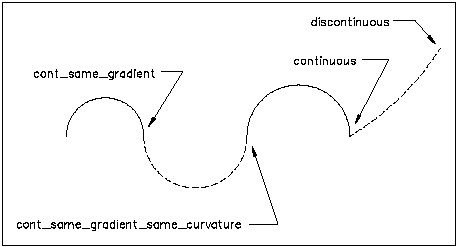Natural language names
 | Transition Code |
 | Enumération des types de transition |
 | Transition Code |
 | Enumération des types de transition |
The IfcTransitionCode indicated the continuity between consecutive segments of a curve or surface.
EXAMPLE In ContSameGradient the tangent vectors of successive segments will have the same direction, but may have different magnitude.
Figure 335 illustrates transition types
NOTE The figure is quoted from ISO 10303-42.
 |
|
Figure 335 — Transition code |
NOTE Definition according to ISO/CD 10303-42:1992
This type conveys the continuity properties of a composite curve or surface. The continuity referred to is geometric, not parametric continuity.
NOTE Type adapted from transition_code defined in ISO 10303-42.
HISTORY New Type in IFC1.0
| Constant | Description |
|---|---|
| DISCONTINUOUS | The segments do not join. This is permitted only at the boundary of the curve or surface to indicate that it is not closed. |
| CONTINUOUS | The segments join but no condition on their tangents is implied. |
| CONTSAMEGRADIENT | The segments join and their tangent vectors or tangent planes are parallel and have the same direction at the joint: equality of derivatives is not required. |
| CONTSAMEGRADIENTSAMECURVATURE | For a curve, the segments join, their tangent vectors are parallel and in the same direction and their curvatures are equal at the joint: equality of derivatives is not required. For a surface this implies that the principle curvatures are the same and the principle directions are coincident along the common boundary. |
<xs:simpleType name="IfcTransitionCode">
<xs:restriction base="xs:string">
<xs:enumeration value="discontinuous"/>
<xs:enumeration value="continuous"/>
<xs:enumeration value="contsamegradient"/>
<xs:enumeration value="contsamegradientsamecurvature"/>
</xs:restriction>
</xs:simpleType>
TYPE IfcTransitionCode = ENUMERATION OF (
DISCONTINUOUS,
CONTINUOUS,
CONTSAMEGRADIENT,
CONTSAMEGRADIENTSAMECURVATURE);
END_TYPE;